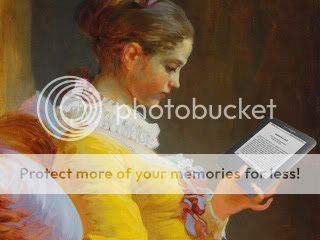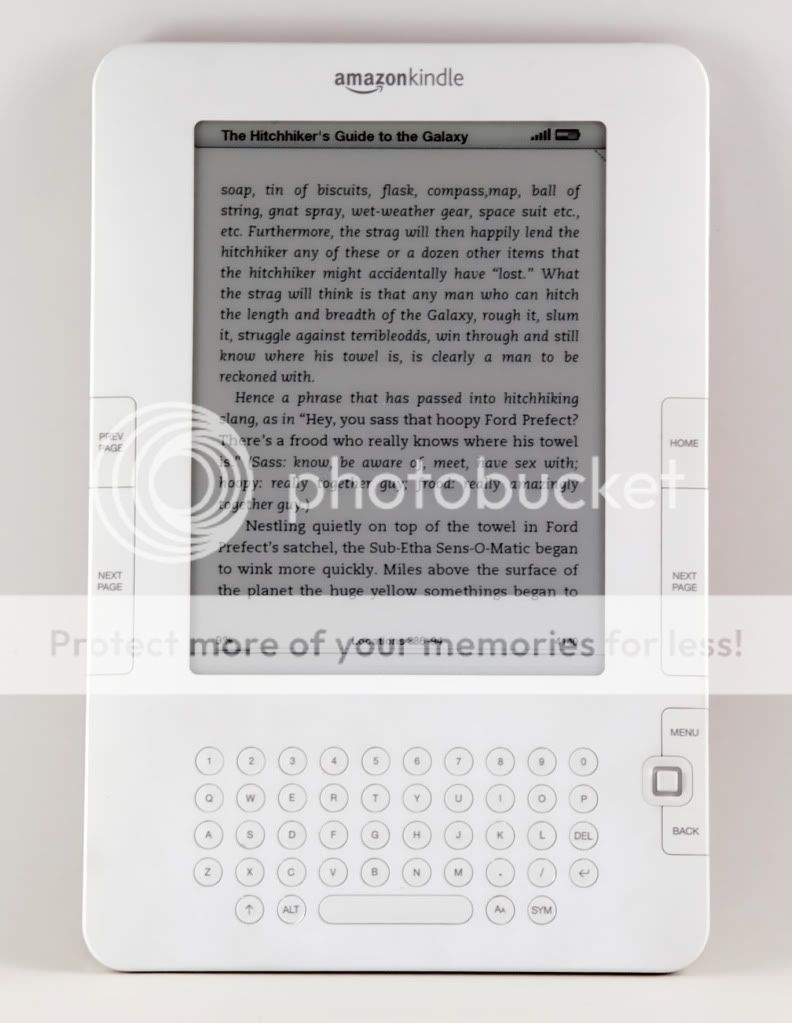Here is my contribution to this week's
Weekly Geeks:
 |
| The future. |
I consider myself to be open-minded when it comes to the format of the books I read. Give me audio books, pop-up books, books with upside-down, spiraling or variable text, books like
The Dictionary of the Kzars which you read out of order of the pages, or books like the Griffin and Sabine trilogy which are told in a series of letters and postcards, some of which are removable or stuffed inside envelopes – if it can be read or listened to, I’ll read it or listen to it as long as the subject interests me.
 |
| The immediate past. |
E-books are no exception. I have been reading them on my computer since I discovered Project Gutenberg way back in the mists of the 20th century and I knew that with the advent of portable computers it would only be a matter of time until someone came up with a dedicated device for reading books on a screen. As a matter of fact it surprised me that it didn’t happen sooner.
Reading books on a computer screen has the drawback of tiring the eyes more quickly than by reading from a printed page, because of screen glare, flicker and/or backlighting, although I personally don’t feel much of a difference. This is perhaps because I have had the sense to change the standard brightness and lightness and sometimes also the hue settings of the computer screens I use, so that there are no brilliant white surfaces on the screen to dazzle my eyes, and I also take care to make sure there is no reflected glare.
 |
| I want one! (maybe) |
E-readers, with their e-paper/e-ink technologies that make the text on the screen feel like regular paper and ink to the eye are a leap forward in e-book presentation. When they first appeared on the scene they were really more like nifty toys rather than serious contenders for popularity against physical books, but fast advances in the technology have turned them from nice gadgets into seriously useful devices.
**
I am not only a reader but also a traveller. This means that when I travel, I take books with me, usually too many of them. Carrying the weight of all the books I have brought along plus the books I have bought during the journey can lead to physical strain. At the beginning of this year I was considering buying an e-reader just to ease my burdens when travelling, but now I am determined to do so, not only for travelling but also for reading books I know I want to read but can’t borrow from the library and don’t particularly want to add to my physical library. E-books also have the advantage that I can buy them from abroad directly over the Internet without having to pay the value-added tax, import tax and handling fee involved in importing physical books through the mail. It only remains for me to do the research needed to decide which device I would prefer and to decide whether perhaps I should really splash out and get an iPad which can act as more than just an e-reader.
 |
| Soon to be no more for this reader? |
Whichever e-reader I do choose, it will have to have the capacity to show images – if only in black on white – because the biggest use for me besides the purely recreational will, at least to begin with, be to replace the brick-thick guidebooks I have been lugging around on my journeys and give me the ability to carry around a whole library of Lonely Planets and Rough Guides – if I so choose – in one book-sized device and enable me to use the maps and write notes and comments to my heart’s content. (When they start offering an e-reader with a built-in GPS system I will definitely be among the first in line to buy it).
For a person like me, who grew up with the smell of books in my nostrils and the texture of them under my fingers, physical books will continue to be a more enjoyable sensory experience than reading e-books. E-readers will therefore never completely replace my physical library but they can and will, in time, supplement and even replace parts of it. There are lots of books I would like to keep for later re-reading but don’t feel the need to keep on my shelves, and also books that I know I will only read once and can therefore dispense with the buying of physical copies that need to be lugged, post-reading, to wherever it is I choose to donate them (they sell for so little that it isn’t worth the effort to try). Then there are those 600+ page novels that I occasionally get the urge to read but are really too heavy for my hands to hold for long.
 |
| Part of my unruly library. |
Right now, I have around 2000 books on my shelves. With an e-book reader in my possession this great dust-catcher of a library could be pared down to about 600 books: my favourite volumes, large format photography and coffee-table books, comic books and graphic novels, cookbooks, beloved old childhood favourites, beautiful bindings, favourite covers, reference books not available online or in e-editions, and valuable books, all displayed to advantage instead of crammed double-deep into the overflowing shelves and whirling up dust whenever I pull one out.
 |
| The current situation. |
While I have yet to actually try out an actual e-book reader, I have already become acquainted with the Kindle set-up, having installed Kindle for PC on my laptop. So far I haven’t bought any e-books, but I have downloaded a considerable library from Project Gutenberg and a few promotional freebies, in addition to what has been gifted to me for reviewing. It has been mostly nice so far. The controls are intuitive and easy to figure out, but already I am becoming unhappy with the lack of mobility. It isn’t exactly easy to read a book off a laptop while eating breakfast, at least at my tiny kitchen table, and taking it with me to the toilet is out of the question, whereas I could do both with an e-reader; although I would like to stress that (lest you take me for a complete slob), just as I do with physical books, I would never do both with the same item.






Comments
I agree that the e-reader itself came about later than I thought it would and I am getting a little frustrated that it's taking them so long to pin down a product that "Works".
Love the pic of your bookshelf - reminds of mine... totally out of control and filled with my kids toys and drawing other such little nonsense...
Thank you for taking part this week...
have a great weekend...
E.H>